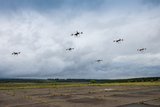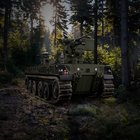Aurora's DA42M-OPV on track for Summer 2010 flights
Aurora Flight Sciences announced today that the DA42M aircraft that will serve as its Optionally Piloted Vehicle (OPV) prototype has arrived at its Manassas, Virginia facility.
The DA42M is a 4-place, twin-engine general aviation aircraft produced by Diamond Aircraft in Austria. The aircraft that will become the prototype for Aurora's OPV was originally used by Diamond as a prototype for the DA42 Multi-Purpose Platform (MPP) development program. Over the past several months, the aircraft has been upgraded with Austro E300 heavy fuel engines.
Aurora's DA42M-OPV, named "Centaur", adds an extensive suite of propriety electronics and software that retains all of the manned mission capability while also enabling the capability to conduct missions with no pilot onboard. This "optionally piloted" configuration is unique to the Aurora version of the DA42M.
"The Centaur has roughly the same payload and range performance as the MQ-1 Predator UAV," said Aurora President John Langford, "but it has several important advantages. First, it can be flown with a pilot onboard, which will facilitate operation in the National Airspace System. Second, it has two engines, which gives greater reliability and safety. Third, the Centaur is easily reconfigurable so it can carry a variety of payloads. Finally, it has extremely low operating costs. We see it as a crossover product with enormous potential in many markets."
Development of the Centaur began in August of 2009. The Preliminary Design Review was completed last month. Aurora expects to make its first flight in the summer of 2010 and to begin deliveries in 2011. In its manned aircraft mode, the Centaur is intended to retain the DA42's normal-class FAA certification. When operated in the unmanned mode, it is expected to fly under an Experimental certification.
The Centaur's planned first mission is mapping the ice pack over Greenland, as part of a NASA experiment being proposed by Harvard's Prof. James G. Anderson. For this mission, a removable "belly pod" housing the radar will be installed underneath the aircraft. An optional nose pod allows other payloads to be installed in the nose.
Source: Aurora Flight Sciences
More from Uncrewed Vehicles
-
![Ready for the race: Air separation drone swarms vs. air defence systems]()
Ready for the race: Air separation drone swarms vs. air defence systems
As the dynamics of aerial combat rapidly evolve, Chinese scientists have engineered a sophisticated air separation drone model that can fragment into up to six drones, each capable of executing distinct battlefield roles and challenging the efficacy of current anti-drone defences such as the UK’s Dragonfire laser system.
-
![Israel’s MALE UAVs ‘must adapt’ to Iranian-made air defences]()
Israel’s MALE UAVs ‘must adapt’ to Iranian-made air defences
Advancements in air defence technologies have begun to reshape aerial combat dynamics in the Middle East, as illustrated by recent events involving the Israeli Air Force and Hezbollah.
-
![Hundreds more UAS sent to Ukraine forces with thousands more on the way]()
Hundreds more UAS sent to Ukraine forces with thousands more on the way
Both sides of the Russia-Ukraine war have been using UAS for effective low-cost attacks, as well as impactful web and social media footage. Thousands more have now been committed to Ukrainian forces.
-
![AI and software companies selected for US Army Robotic Combat Vehicle subsystems]()
AI and software companies selected for US Army Robotic Combat Vehicle subsystems
The US Army has intentions to develop light, medium and heavy variants of the Robotic Combat Vehicle (RCV) as part of the branche’s Next Generation Combat Vehicle family.
-
![DroneShield to improve software of DroneSentry-X C-UAS system under new contract]()
DroneShield to improve software of DroneSentry-X C-UAS system under new contract
DroneSentry-X, a cross-vehicle compatible, automated 360° C-UAS detect and defeat device, can offer 360° awareness and protection using integrated sensors. According to its manufacturer, it is suitable for mobile operations, on-site surveillance and on-the-move missions.


























